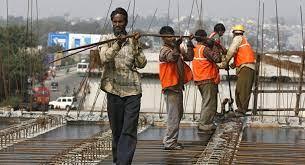The State of Working India Report, 2022-23: Key Findings
The Indian story of economic growth and structural transformation since 1992 is an intriguing one. Rapid growth has not led to overall development but wealth has got concentrated in the hands of the few. The vast gulf has never been starker than today, when the government in power is working avowedly for corporate interests, but with the partial electoral approval of the poor and the working classes. This presents a unique set of challenges to activists who organize against inequality. The annual ‘State of Working India Report’ produced by scholars associated with Azim Premji University, provides us with an important glimpse of the employment scenario and adds much needed information to our activist arsenal.
This year’s report makes use of official datasets such as the NSSO’s Employment-Unemployment Surveys, the Periodic Labour Force Surveys, the National Family Health Surveys, Annual Survey of Industries, and the Economic and Population Censuses. The authors also make use of a primary survey carried out in rural Karnataka and Rajasthan, the India Working Survey. This year’s report goes further than earlier editions and makes extensive use of regression analysis to offer more precise estimates of the impacts of structural change on employment conditions and outcome gaps.
Here we present the key findings of this year’s report.
(1) Faster Structural Change: After stagnating since the 1980s, the share of workers with regular wage or salaried work started increasing in 2004, going from 18% to 25% for men and 10% to 25% for women. Between 2004 and 2017, around 3 million regular wage jobs were created annually. Between 2017 and 2019 this jumped to 5 million per year. Since 2019, the pace of regular wage jobs creation has decreased due to the growth slowdown and the pandemic.
(2) Upward Mobility Has Increased: In 2004 over 80% of sons of casual wage workers were themselves in casual employment. This was the case for both SC/ST workers and other castes. For non-SC/ST castes, this fell from 83% to 53% by 2018 and incidence of better-quality work such as regular salaried jobs increased. It fell for SC/ST castes as well, but to a lesser extent (86% to 76%).
(3) Caste-based Segregation Has Reduced: In the early 1980s Scheduled Caste workers were more than 5 times over-represented in waste-related work and over 4 times in leather-related work. This has declined rapidly over time, though it is not completely eliminated as of 2021-22. In the leather industry, the representation index declined sharply to 1.4 in 2021. In waste management and sewerage, over-representation of SCs decreased to 1.6 times in 2011 before increasing slightly again.
(4) Gender-based Earnings Disparities Have Reduced: In 2004, salaried women workers earned 70% of what men earned. By 2017 the gap had reduced and women earned 76% of what men did. Since then, the gap has remained constant till 2021-22.
(5) Connection between Growth and Good Jobs Remains Weak: Since the 1990s year-on-year non-farm GDP growth and non-farm employment growth are uncorrelated with each other suggesting that policies promoting faster growth need not promote faster job creation. However, between 2004 and 2019, on average growth translated to decent employment. This was interrupted by the pandemic which caused larger growth in distress employment.
(6) Unemployment Is Falling but Remains High: Post-Covid the unemployment rate is lower than it was pre-Covid, for all education levels. But it remains above 15% for graduates and more worryingly it touches a huge 42% for graduates under 25 years.
(7) After Falling for Years, Women’s WPR Is Rising, but Not for the Right Reasons: After falling or being stagnant since 2004, female employment rates have risen since 2019 due to a distress-led increase in self-employment. Before Covid, 50% of women were self-employed. After Covid this rose to 60%. As a result,earnings from self-employment declined in real terms over this period. Even two years after the 2020 lockdown, self-employment earnings were only 85% of what they were in the April-June 2019 quarter.
(8) Gender Norms Continue to Be Significant for Women’s Employment: As husband’s income rises, women are less likely to work. In urban areas, after the husband’s income crosses Rs. 40,000 per month, the chance of the wife working increases again (i.e., there is a U-shaped relationship). There is also a strong intergenerational effect of gender norms. Compared to households where there is no mother in-law present, married women living in households where the mother-in-law is present but not employed are 20% (rural) to 30% (urban) less likely to be employed. However, if the mother-in-law is employed herself, daughters-in-law are 50% (rural) to 70% (urban) more likely to be employed.
(9) Lower Caste Entrepreneurs Are Still Rare: We find that even in the smallest firm sizes, SC and ST owners are under-represented compared to their share in the overall workforce. But even more significantly, SC and ST owners are barely represented among firms employing more than 20 workers. Correspondingly, upper caste overrepresentation increases with firm size. n

